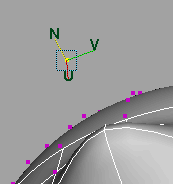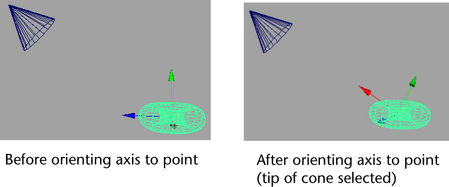Shows a move manipulator for the selected objects or components.
options
Choosing a coordinate system for the
Use the window to specify the coordinate system () for the .
-
-
Moves an object in object space coordinate system. Axis orientation includes rotations on the object itself. If several objects
are selected, each object moves the same amount relative to its own object space coordinate system.
-
-
Aligns the object to the rotation of the parent object. Movement is constrained to those axes in the local space coordinate
system. The object is aligned to the rotation of the parent object and does not include the rotations on the object itself.
If several objects are selected, each object moves the same amount relative to its own object space coordinate system.
-
-
Moves in the world space coordinate system. The object is aligned to the world space axis. This is the default.
-
-
Moves selected vertices or CVs in the U or V direction of the surface. Typically you would use this option for small sets
of CVs. The manipulator indicates the surface Normal, U, and V directions.
When you select Normal, the Update [UVN] Triad check box appears. Turned on, this option causes the manipulator orientation
to reflect the moved surface rather than the original surface. This is the default. Turned off, the manipulator retains the
orientation for the original surface.
-
-
’s axes on the object. If you have set the in the object’s to a different value (which offsets the orientation of the object relative to the orientation of the object's local rotation
axis) this attribute will have an affect; otherwise, is the same as Object.
-
-
Moves selected vertices or CVs along the average of their combined normals.
-
-
(This setting does not work with on.) Sets the to move objects along the axis of a live object. Most commonly, you would make a construction plane live, but any object
can be set live. When you have a live object and select this option, the move arrows of the align to the live construction plane. (The geometry of the live object doesn’t matter; the move aligns to the axes of the
live object.)
-
-
Enter the x, y, and z offset of the custom axis in radians.
-
-
You can set the to move the selected object along a axis defined by selecting a point.
To set a point in order to change the move axis
- Select an object.
- Click .
- Select a point in the scene. It can be a point on any object, including the currently selected object.
The axis of the changes.
You can see the new axis settings in the three boxes under .
-
-
You can set the to move the selected object along an axis defined by an edge.
To set an edge in order to change the move axis
- Select an object.
- Click .
- Select an edge in the scene. It can be an edge on any object, including the currently selected object.
The axis of the changes.
You can see the new axis settings in the three boxes under .
-
-
You can set the to move the selected object along an axis defined by a face.
To set a face in order to change the move axis
- Select an object.
- Click
- Select a face in the scene. It can be a face on any object, including the currently selected object.
The axis of the changes.
You can see the new axis settings in the three boxes under .
-
-
When on, moving a parent object does not move its children.
-
-
When this option is selected, moving components in the scene view causes the corresponding UVs to move accordingly in the
UV space. The net result is that the texture does not become warped.
-
-
The setting enables the option and lets you specify the amount an object is moved in increments (determined by the value).
-
-
While Maya moves the object, relative spacing is maintained. Turn this option off if you don’t want to preserve relative spacing
while translating.
-
-
Enter a value to determine the amount an object is moved in increments when the option is selected.
-
-

Allows you to quickly move components, position objects in a scene, and make adjustments to a specific mesh. See Move components with the Tweak mode.
NoteIf you set the active handle of the to a particular axis while in , then the active handle will remain on the same axis even if you select multiple faces. If you want to use with the center handle, then make the center handle the default handle.
Joint Orient Settings

-
-
When on, joint offset values are automatically updated when you move joints in a skeleton, ensuring that the parent joint
points correctly toward the first child joint.
See also Move joints.
-
-
When on, all joints you create with the are set to align with the world frame. Each joint’s local axes have the orientation of the world axis, and the other settings are disabled. When off, you can specify the joint alignment using the other settings described below.
-
-
Lets you specify the primary local axis for the joint. This is the axis that points down the bone that extends from this joint.
Tip
If you want a joint to rotate about a particular axis, that axis must not be the . For example, a joint cannot rotate about its local X-axis if its orientation is set to X.
-
-
Lets you specify which local axis to use as the secondary orientation for the joint. Select one of the two remaining axes.
To have Maya determine the automatically, set to .
Note
You cannot set the same axis for both the and orientation. If you set either option to use an axis already specified, Maya automatically switches the other option to use
a different axis.
-
-
Lets you set the direction (positive or negative) in which the secondary axis points.
The following settings let you snap to polygon face centers and vertices while translating.
-
-
Turned on by default. This means that while Maya moves the component, relative spacing is maintained. Turn this option off
if you don’t want to preserve relative spacing while translating and snapping polygonal components.
- — or
-
These settings let you move and snap to a live polygon’s components (face centers and vertices).
To snap to components on a live polygon
- Select the polygon you want to snap to and click the icon on the
 .
.
- Double-click the Move icon from the to open the window
 .
.
- In the window, select a setting— or .
- Click the object you want to move and use the center manipulator handle to drag. The movement is restrained to the nearest face centers or vertex locations of the live polygon.
Note
The arrow manipulator handles do not restrain movement.



 .
.
 .
.